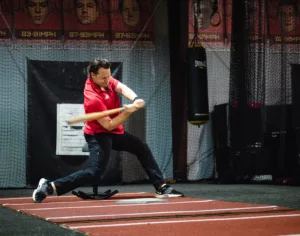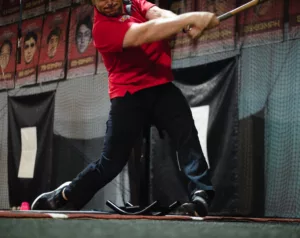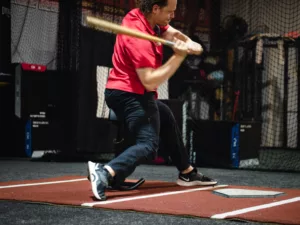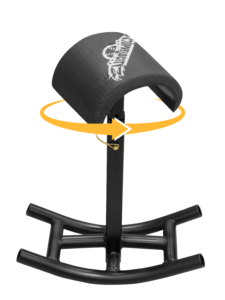Understanding the differences between hitting kinematics in young and adult baseball players is critical for developing successful coaching approaches and improving Hitting Exit Velocity. In our case study, "A Comparison of Age Level on Baseball Hitting Kinematics," we used a high-speed motion analysis system to compare the hitting mechanics of 12 skilled juvenile and 12 skilled adult baseball players. The study discovered numerous crucial kinematic and temporal differences between these two groups, which could have a major impact on maximizing striking exit velocity.
We go into the precise findings of our case study in this article, highlighting how adult batters had higher peak angular velocities and bat linear velocity at bat-ball contact than young hitters. We also discuss the necessity of learning appropriate hitting mechanics at an early age, as this can help players retain these skills as they progress to higher levels of baseball. Coaches and trainers can build tailored training programs to help players of all ages improve their hitting exit velocity and overall performance by studying the changes in hitting kinematics between youth and adult players.
Here are some key takeaways from this article on Maximizing Hitting Exit Velocity:
- Kinetic Energy Transfer: The lower extremity and trunk play a critical role in generating and transferring kinetic energy through the body during baseball hitting.
- Angular and Linear Velocities: Adult hitters demonstrate greater angular and linear velocities in their swings compared to youth hitters, contributing to better performance.
- Proper Hitting Mechanics: Developing proper hitting mechanics at a young age is crucial for a smooth transition to higher levels of baseball in the future.
- Similarities and Differences: Despite some differences in velocity parameters, many kinematic and temporal hitting parameters show similarities between skilled youth and adult hitters.
- The Stride Excelerator 360: A valuable training tool designed to help players develop proper hitting mechanics and reach their full potential.
- Unlock Your Hitting Exit Velocity Potential: Enhance your performance by incorporating the Stride Excelerator 360 into your training routine and master the techniques discussed in this article.
Kinetic Energy Transfer in Hitting Exit Velocity: The Role of the Lower Extremity
 Kinetic energy transfer plays a crucial role in baseball hitting, and understanding the mechanics behind it can provide valuable insights for both youth and adult hitters. This process begins with the lower extremity, followed by the trunk, and finally the upper extremity. The energy generated in the lower extremity and trunk is transferred up the kinetic chain to the upper extremity, contributing to the large angular velocities generated during a swing. One key aspect of this transfer is the importance of hitting-specific lower extremity and trunk strength and power training. The EMG data analyzed by Shaffer et al. (1993) demonstrated high muscle activity in the lower extremity and trunk, but relatively low muscle activity in the upper extremity, highlighting the significance of proper training in these areas.
Kinetic energy transfer plays a crucial role in baseball hitting, and understanding the mechanics behind it can provide valuable insights for both youth and adult hitters. This process begins with the lower extremity, followed by the trunk, and finally the upper extremity. The energy generated in the lower extremity and trunk is transferred up the kinetic chain to the upper extremity, contributing to the large angular velocities generated during a swing. One key aspect of this transfer is the importance of hitting-specific lower extremity and trunk strength and power training. The EMG data analyzed by Shaffer et al. (1993) demonstrated high muscle activity in the lower extremity and trunk, but relatively low muscle activity in the upper extremity, highlighting the significance of proper training in these areas.
In accordance with the kinetic link principle, peak angular velocities progressively increase and occur later in the swing phase from the knee to the pelvis to the upper torso to the elbows. This sequence contributes to the relatively high bat linear velocities that are generated during a swing. The study's results revealed that the later occurring and significantly greater peak upper torso angular velocity in adult hitters compared with youth hitters helped contribute to the significantly greater peak left elbow extension angular velocity and bat linear velocity at bat-ball contact in the adult hitters.
Understanding and optimizing kinetic energy transfer in baseball hitting can lead to significant improvements in a hitter's performance. For both youth and adult hitters, focusing on the proper mechanics of the lower extremity and trunk can be instrumental in achieving higher bat linear velocities and more effective swings. By ensuring that young players develop proper hitting mechanics early on, they will be better equipped to advance their skills and maintain strong performance as they progress to higher levels of baseball in their adult years.
In conclusion, the role of the lower extremity and trunk in kinetic energy transfer during baseball hitting is fundamental to achieving optimal performance. By emphasizing the importance of proper mechanics and strength training in these areas, hitters can work towards improving their swings and increasing bat linear velocities. This understanding and application of kinetic energy transfer principles will ultimately benefit players as they progress through different stages of their baseball careers.
Comparing Angular and Linear Velocities Between Youth and Adult Hitting Exit Velocity
 The comparison of angular and linear velocities between youth and adult batters reveals important changes in mechanics and performance. The angular and linear velocities of a hitter's swing are important elements to consider since they directly affect the speed and power of the bat as it makes contact with the ball. Linear and angular velocity parameters, such as pelvis, upper torso, elbow extension, and knee extension angular velocities, as well as linear bat velocity, exhibited greater variability between youth and adult hitters in the study, with the majority of these parameters being significantly greater in adult hitters.
The comparison of angular and linear velocities between youth and adult batters reveals important changes in mechanics and performance. The angular and linear velocities of a hitter's swing are important elements to consider since they directly affect the speed and power of the bat as it makes contact with the ball. Linear and angular velocity parameters, such as pelvis, upper torso, elbow extension, and knee extension angular velocities, as well as linear bat velocity, exhibited greater variability between youth and adult hitters in the study, with the majority of these parameters being significantly greater in adult hitters.
One important discovery was that adult hitters have a higher peak angular velocity of the upper torso than child hitters. This differential in angular velocity, combined with adult batters' longer arms and bat length, offers them a mechanical edge over juvenile hitters. As a result, this advantage adds to adult hitters having much higher linear bat velocity than their younger counterparts. The disparities in angular and linear velocities between the two groups can be linked to factors such as physical growth, strength, and experience, all of which have an impact on the mechanics and effectiveness of a hitter's swing.
Despite these variations, the researchers discovered similarities in the hitting mechanics of young and old players. Both groups showed kinetic energy transfer sequencing from bigger, slower-moving portions earlier in the swing to smaller, faster-moving regions later in the swing. This persistent trend suggests that appropriate hitting mechanics are created and reinforced at a young age, and that learning these principles might lay the framework for adult success.
In conclusion, comparing angular and linear velocities of child and adult batters reveals considerable disparities in performance, owing mostly to characteristics such as physical development, strength, and experience. These distinctions show the significance of knowing and optimizing hitting mechanics at all levels of competition. Players can create the groundwork for continued improvement and success in their baseball careers by focusing on learning good hitting methods early on.
The Importance of Proper Hitting Mechanics in Youth Baseball Development
 The significance of excellent hitting mechanics in the development of youth baseball players cannot be emphasized. Young players can build the required abilities and muscle memory that will contribute to their success as they go through the many levels of baseball by creating a firm foundation in hitting techniques early on. This foundation not only guarantees that young players use their bodies properly and effectively throughout the hitting process, but it also helps to limit the risk of injury as they physically grow and mature.
The significance of excellent hitting mechanics in the development of youth baseball players cannot be emphasized. Young players can build the required abilities and muscle memory that will contribute to their success as they go through the many levels of baseball by creating a firm foundation in hitting techniques early on. This foundation not only guarantees that young players use their bodies properly and effectively throughout the hitting process, but it also helps to limit the risk of injury as they physically grow and mature.
Learning good hitting mechanics at an early age assists young players to gain a better knowledge of the kinetic link principle, which is the transfer of energy throughout the swing from bigger, slower-moving body segments to smaller, faster-moving body segments. This knowledge enables players to optimize their swings and generate the most power and bat speed possible. As their baseball careers progress, the abilities and tactics they learned in their formative years can be improved and built upon, allowing for continuing growth and advancement.
Furthermore, appropriate hitting mechanics aid in the development of a more consistent and precise swing. Consistency is essential for young players because it allows them to make better contact with the ball and, as a result, become more successful hitters. Coaches and parents can help youth players build confidence and a sense of mastery by emphasizing on appropriate hitting mechanics throughout practice and training sessions, encouraging a passion for the game and a desire to continue playing.
In conclusion, the long-term benefits of excellent hitting mechanics in youth baseball development are clear. Players can set a solid foundation for their baseball careers by learning and reinforcing these strategies from an early age. Coaches and parents play an important role in teaching young players proper mechanics, allowing them to enjoy the game, limit their risk of injury, and ultimately attain their full potential on the field.
Unlock Your Hitting Exit Velocity Potential: Stride Excelerator 360
 Don't let your young athlete pass up the opportunity to fully perfect their hitting mechanics. Purchase the Stride Excelerator 360, which is only available at Topvelocity.net/se360, to invest in their future success. This ground-breaking training tool is intended to help baseball players of all ages develop the appropriate hitting mechanics that will catapult them to new heights in their careers.
Don't let your young athlete pass up the opportunity to fully perfect their hitting mechanics. Purchase the Stride Excelerator 360, which is only available at Topvelocity.net/se360, to invest in their future success. This ground-breaking training tool is intended to help baseball players of all ages develop the appropriate hitting mechanics that will catapult them to new heights in their careers.
The Stride Excelerator 360 focuses on the most important components of hitting mechanics, such as kinetic energy transfer, angular and linear velocities, and the role of the lower extremity and trunk in power generation. Players can improve their technique, increase bat speed, and build a more consistent and accurate swing by including the Stride Excelerator 360 into their training regimen.
Don't put off giving your young player the competitive edge they need to thrive any longer. Visit Topvelocity.net/se360 right now to buy the Stride Excelerator 360 and start realizing their full potential. Assist them in becoming the best hitters they can be and putting them on the path to a successful and rewarding baseball career. Act now to invest in their future by purchasing the Stride Excelerator 360, the key to achieving optimal hitting mechanics and performance!




